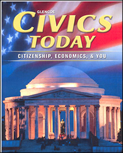Civics Today Citizenship, Economics, & YouChapter 22:
Business and LaborWeb Activity Lesson PlansIntroduction
In this chapter you learned about the different forms of business organization. Many people who work for these businesses choose to join labor unions. Organized labor operates at the local, national, international, and federation levels. At the federation level is the AFL-CIO. The AFL-CIO was formed in 1955 by the merger of the American Federation of Labor and the Congress of Industrial Organizations. Today it represents more than 13 million men and women nationwide.
Lesson Description
Students will visit the official Web site of the AFL-CIO. They will browse through links describing how and why people join unions. Then they will answer a series of questions and write an editorial for a newspaper. Remind students that this site contains a bias in favor of unions.
Instructional Objectives- The learner will be able to identify differences between union and nonunion workers in the areas of pay and benefits.
- The learner will be able to identify bias.
- The learner will be able to write an editorial concerning union membership.
Student Web Activity Answers- Union workers earn about 30 percent more than nonunion workers.
- 97 percent of union workers have medical benefits compared to 85 percent of nonunion workers.
- The average difference in pay for workers in free states and those in right-to-work states is that those in right-to-work states earn about 13.1 percent more than those in free states.
- Answers will vary depending on the state selected.
- Students' editorials will vary.
 | 




